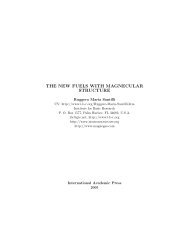Toroidal configuration of the orbit of the electron of the hydrogen ...
Toroidal configuration of the orbit of the electron of the hydrogen ...
Toroidal configuration of the orbit of the electron of the hydrogen ...
Create successful ePaper yourself
Turn your PDF publications into a flip-book with our unique Google optimized e-Paper software.
Energy E, a.u.-4-5-6-70 200 400 600 800 1000bFigure 12: Variational ground state energy <strong>of</strong> <strong>the</strong> <strong>hydrogen</strong> atom in <strong>the</strong>magnetic field, Eq. (3.38), as a function <strong>of</strong> <strong>the</strong> magnetic field intensity;b = B/B 0 , B 0 = 2.4 · 10 9 Gauss, 1 a.u. = 27.2 eV.4 DiscussionIn a physical context, <strong>the</strong> used adiabatic approximation implies that <strong>the</strong>position <strong>of</strong> <strong>the</strong> nucleus is not ”fixed” in <strong>the</strong> (r, ϕ) plane. Indeed, <strong>the</strong>re is noreason for <strong>the</strong> nucleus to stay ”exactly” at <strong>the</strong> center <strong>of</strong> <strong>the</strong> <strong>orbit</strong> when <strong>the</strong>Coulomb force in <strong>the</strong> transverse plane is totally ignored.In contrast, in <strong>the</strong> z direction, we have more complicated situation,namely, <strong>the</strong> magnetic field leads to <strong>the</strong> effective interaction potential C(z),which is finite at z = 0 and is Coulomb-like in <strong>the</strong> long-range asymptotic.Hence, <strong>the</strong> position <strong>of</strong> <strong>the</strong> nucleus remains to be fixed in <strong>the</strong> z directionrelative to <strong>the</strong> <strong>orbit</strong> <strong>of</strong> <strong>the</strong> <strong>electron</strong> (bound state).Due to <strong>the</strong> (crude) Coulomb approximation <strong>of</strong> Sect. 3.1.1, <strong>the</strong> <strong>electron</strong>probability density <strong>of</strong> <strong>the</strong> <strong>hydrogen</strong> atom under very intense magnetic field,at n = 1, appears to be <strong>of</strong> ra<strong>the</strong>r nontrivial form schematically depicted inFig. 6.More accurate approach may yield some different <strong>electron</strong> charge distributionsbut we expect that <strong>the</strong> symmetry requirements (namely, <strong>the</strong> axialsymmetry and <strong>the</strong> (anti)symmetry under inversion z → −z) would lead againto a toroidal <strong>orbit</strong>, which is splitted into two identical coaxial <strong>orbit</strong>s (<strong>the</strong> toriiare separated) similar to that shown in Fig. 6, or to an unsplitted one (<strong>the</strong>two torii are superimposed) as shown in Fig. 8.Accurate analytic calculation <strong>of</strong> <strong>the</strong> ground and excited <strong>hydrogen</strong> wave25














